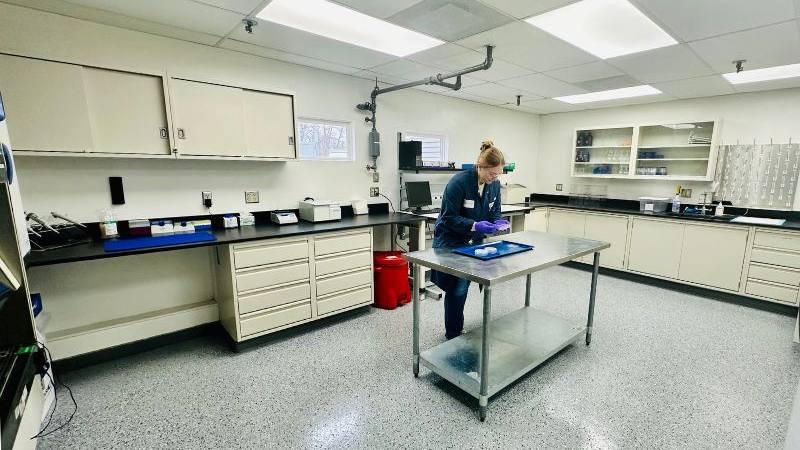Global Perspectives: Agribusiness Association Leaders Share Goals for 2025
The international agricultural community is working toward sustainable goals — not only for the environment but also for growers’ livelihoods. This integrated approach calls for different perspectives and methods as farmers aim to increase productivity to feed a growing population.
AgriBusiness Global asked leaders from 20 associations from around the world to share their goals for the upcoming year. View their responses below:
INTERNATIONAL

Emily Rees. Photo credit: CropLife International, Jennifer Lewis
Emily Rees, President
CropLife International
CropLife International’s goal for 2025 is to sustain and advance the momentum built during this year for balanced approaches that integrate agricultural innovation, risk-based assessments, and regulations that foster plant science research and development. Because the biggest challenges we are all facing – lack of resilience in our food security, biodiversity loss, and climate crisis – can move toward tangible redress and chart a fresh path forward if we underpin global policy with these principles
Jennifer Lewis, Executive Director
International Biocontrol Manufacturers Association (IBMA)

Jennifer Lewis
IBMA is focusing on two goals for 2025: Proportionate regulation for biocontrol and to communicate the benefits of biocontrol.
Achieving proportionate regulation starts with getting an EU wide biocontrol definition and fast track evaluation procedure for biocontrol written into a legislative proposal.
Following an election in June 2024, the European Union is now going through a process of appointing new commissioners. In September 2024, the political Mission letters for the Agriculture and Health Commissioners were released indicating the direction of the next 5 years in Europe.
Both Commissioners have been mandated to address biocontrol. The Health Commissioner “to work to improve sustainability including… accelerating the use of biocontrol” and the Agriculture Commissioner “to strengthen the competitiveness, resilience and sustainability of the agriculture sector” and “following up on the report and recommendations of the Strategic Dialogue for the Future of Agriculture in the EU”.
The Strategic Dialogue recommends the delivery of a robust legislative framework for biocontrol products and approaches by 2025. IBMA will continue working with the EU Commission sharing possible legislative approaches.
For our second goal, we believe it is crucial to increase understanding and awareness of biocontrol. We will build on our successful field trip program where we bring farmers’ organizations, policymakers, and influencers to see biocontrol in use on farms.
We will provide evidence reports on the benefits of biocontrol for biodiversity and its potential to decarbonize agriculture. It is not always easy to understand the full impact of biocontrol technologies, so together with our members, we will showcase biocontrol in action and why it is paramount that farmers have access to these tools now, and not in a decade.
Johan Swinnen, Director General
International Food Policy Research Institute (IFPRI)

Johan Swinnen
IFPRI’s vision is a world free of hunger and malnutrition. Clearly, this is a longer-term vision that is meant to align with the global development agenda in the coming years.
In the interim, as part of CGIAR, the world’s largest agricultural innovation network, IFPRI researchers are working every day to transform food, land, and water systems under a climate crisis. We do this by generating evidence-based policy solutions based on demand from our partners. Our hundreds of partners include governments, the private sector and agribusinesses, on-the-ground organizations, multilateral organizations, development banks, and more.
2025 marks our 50th anniversary. We are using this time to reflect on our five decades of impact, and to update our strategy for addressing the biggest challenges facing the world in the coming years.
In 2025, we will focus on strengthening our existing partnerships and forging new ones around the globe. More than half of our researchers are based outside of the United States, making our network quite strong. Keeping our research grounded in low- and middle-income countries ensures that it stays relevant to the needs of local populations. Our work through HarvestPlus is a great example. HarvestPlus partners with national agricultural research systems and seed producers to develop varieties of crops that are bred to be rich in essential vitamins and minerals. More than 100 million people in farming households are now eating these nutritious, climate-smart crops, thanks to a network of more than 3,000 partners that have ensured that local producers and consumers will grow and eat them. Moving forward, we aim to multiply our private-public partnerships, and other innovative arrangements.
Another goal we have is to continue researching and supporting innovations along value chains in poorer countries. Agrifood systems are transforming very quickly in middle- and high-income countries but low-income countries have not seen as much growth in agrifood system GDP or employment during the past 20 years. Transforming value chains can lead to agricultural growth, technology spillovers, poverty reduction, and so on. We have a role to play in ensuring that small actors, especially in the mid-stream part of value chains, can access innovations, comply with new standards, and reap the benefits. We are already supporting this work. In Ghana, we evaluated the government’s provision of subsidized farm machines to farmers and private enterprises. Our work found that this scheme has benefited 20,000 farmers, reduced drudgery by up to 30%, and increased yields by up to 24%. Governments need this type of data to make decisions on whether to scale up or scale out innovations.
Lloyd Day, Deputy Director General
Inter-American Institute for Cooperation on Agriculture (IICA)

Lloyd Day
Right now, we have the existential challenge of climate change that is confronting all of agriculture and all of the world. And we’ve put that front and center, so we’ve been very active in trying to prepare our Member States and working with the private sector as well as the Ministers of Agriculture, to both respond and prepare for all the challenges that are coming our way due to climate change.
As we prepare for another administration, and the outcomes related to that, we are preparing for the COP 30 in Brazil.
We are bringing together farmers and ranchers and the Ministers of Agriculture from all 34 Member States to these United Nations Climate Change meetings in order to have a voice for farmers and the whole farm sector, which includes all the input providers, traders, and food companies, so they have a voice and are listened to. We want them to not be viewed as the problem, but really as part of the solution. That’s been a big change that we’ve been trying to do to try and change the narrative related to agriculture for a while.
AFRICA
Debbie Matteucci, Chairperson
South African Bioproduct Organisation (SABO)

Debbie Matteucci
For this year, we’d like to build integrated relationships to leverage the synergy of like-minded leaders to positively impact the biological industry in South Africa.
Through our board, we’ve gathered different voices in our industry. We have trialists, university institutions, distributors, and retailers. Together, we hope to improve the visibility and trust in biologicals for growers. We want to show them it is achievable to put a biological into their program without having to convert to an entire biological program. An integrated pest management approach is very achievable. We want to be a trusted source that growers can get information to build their trust in using biologicals.
A second goal is to improve regulatory compliance. We are looking at different groups of bioproducts and how those should be regulated. Because our regulatory authority has a limited capacity, we are proposing guidelines. As we consider global regulatory bodies, we want to synthesize those standards. We want to finalize guidelines to provide our regulatory authorities with an improved understanding of biologicals. We believe this will create clear requirements for suppliers and assist them in registering their products. Hopefully once there is a clearer path, it will lead to more suppliers.
ASIA-PACIFIC
Parikshit Mundhra, Chairman
Agro Chem Federation of India (ACFI)

Parikshit Mundhra
One of ACFI’s primary goals is to advocate sustainable agriculture by supporting safe and regulated use of agrochemicals. By promoting initiatives like the “Kisan Kalyan” (Farmers’ Welfare) campaign, ACFI aims to ensure that agricultural practices do not harm the environment while meeting the needs of farmers and consumers. This is part of a broader objective to align with the United Nations Sustainable Development Goals by 2030, of which responsible chemical use in agriculture is a critical component. ACFI’s efforts to achieve this include collaborating with government agencies, NGOs, and academic institutions to educate farmers on using crop protection products judiciously, thereby safeguarding soil health and reducing environmental contamination.
Another key goal for ACFI in 2025 is to work closely with Indian regulatory bodies to create a more transparent and efficient regulatory environment for agrochemicals. This involves advocating for a streamlined approval process for new crop protection products and seeking reductions in import duties and GST (Goods and Service Tax) to make them more accessible to farmers. ACFI is also focused on encouraging the government to adopt a pragmatic approach to regulatory policies, which would prevent sudden restrictions on essential chemicals and improve the consistency of guidelines for product registration. The organization sees these efforts as foundational to building a stable regulatory landscape that can support the long-term growth of India’s agricultural sector and improve farmers’ access to essential inputs.
Sun Shubao, President
China Crop Protection Industry Association (CCPIA)

Sun Shubao
First, to promote green, sustainable development. Against the backdrop of sustainable development of global agriculture, one of CCPIA’s primary goals is to promote R&D and promotion of green pesticides and environmentally-friendly crop protection products. By supporting pesticide manufacturers reducing environmental pollution and carbon emissions, CCPIA will promote development of new types of pesticides and biopesticides and promotion and application of biotechnology, thus facilitating the green transition of the industry. That is not only in line with the Chinese government’s goals of carbon peak and carbon neutrality but will also help the pesticide industry realize long-term, healthy development.
Second, to strengthen information communication and enhance the capacity and resilience for guaranteeing the supply of crop protection products. During the pandemic, due to poor transportation, pesticide purchases increased, leading to false prosperity in the global market and a significant rise in pesticide supply capacity. CCPIA’s another primary goal is to enhance understanding and communication of pesticide production and demand by strengthening international cooperation, holding exhibitions, etc., to make sure that pesticide production capacity can meet agricultural demand and will not make the supply side overcrowded.
SiangHee Tan, Executive Director
CropLife Asia

SiangHee Tan
CropLife Asia has set two critical goals for 2025: the regional advancement of a Sustainable Pesticides Management Framework (SPMF) and the enhancement of access to innovation and technology for smallholder farmers. These goals reflect the organization’s commitment to driving sustainable agricultural practices across Asia, addressing both environmental concerns and the needs of smallholders who play a crucial role in the region’s food security.
The SPMF initiative, recently launched by CropLife members globally, is a significant step toward ensuring that pesticides are used in a way that minimizes environmental impact while maximizing agricultural productivity. This framework is essential in Asia, where diverse farming practices and varying levels of regulatory oversight create challenges for consistent and safe pesticide use. By promoting this framework, CropLife Asia aims to harmonize pesticide regulations, enhance farmer education on safe pesticide application, and reduce the risk of environmental contamination. The adoption of SPMF across Asia is vital for creating a sustainable agricultural system that can support long-term food security in the region.
Equally important is CropLife Asia’s focus on making innovative agricultural technologies accessible to smallholder farmers at scale. In many parts of Asia, smallholders are the backbone of the agricultural sector, yet they often lack access to the latest technologies that could improve their productivity and resilience. By enabling smallholder access to climate-smart technologies, CropLife Asia aims to empower these farmers to adapt to and mitigate the impacts of climate change, ensuring a more resilient and sustainable food system.
Pradip Dave, President
Pesticides Manufacturers & Formulators Association of India (PMFAI)

Pradip Dave
As a national Association representing Indian Agrochemical Industry, PMFAI promotes innovations in Formulations technologies; support indigenous development of Crop Protection technologies and environmental sound use of crop protection & public health products so as to ensure high quality and abundant food and fibre for the growing population in India and all over the world, thus enhancing food security. Working towards making India as a major Global Agrochemical sourcing hub is one of the prime goals for PMFAI. Of course, the goal cannot be achieved in short period but improving the growth year over year is important for us.
Indian Agrochemical Industry has the potential to Double its Growth in next 5 years, in which exports being key driver along with significant domestic market growth. Indian Agrochemical sector has the potential to increase the exports to USD 9.0 Billion in another 4 years’ time. Indian Agrochemical business has significant advantage over competitors to provide quality agrochemicals at most economic cost globally, due to availability of low cost raw-material and technically qualified manpower at lower cost.
Encouraging investments in R&D and backward integration to increase domestic manufacturing capacities for multiple products from basic stage is another important goal. Marginalizing imports and avoiding dependency on imports of key intermediates and actives is another goal. Towards this, PMFAI also seeks support from Government of India with favorable policies and support like production linked incentive (PLI) scheme.
Training and education of Farmers on safe and judicious use of Agrochemicals is another important activity for PMFAI.
EUROPEAN UNION
Arne Pingel, President
European Biostimulants Industry Council (EBIC)

Arne Pingel
One of the pillars of EBIC’s mid-term strategy is to create a level playing field for biostimulants in Europe. The implementation of the Fertilising Products Regulation (FPR) in July 2022 was a milestone achievement for EBIC, as biostimulants were recognized for the first time by regulators. However, there are several outstanding issues that prevent this important legislation from delivering a truly harmonized market in the EU, including the exclusion of certain microbial products, restrictive mitigation measures concerning some animal by-products, and excessive data requirements related to the Registration, Evaluation, Authorisation, and Restriction of Chemicals (REACH). EBIC’s manifesto calls upon regulators to empower farmers with plant biostimulant solutions by reducing regulatory barriers and providing incentives for farmer uptake. So, my first goal for EBIC in 2025 is for these issues to be addressed.
Secondly, I want us to make progress towards EBIC’s newly published vision: sustainable agriculture supported by the global adoption of plant biostimulants. It is only by working closely with farmers, policymakers and those in the wider food system that we can broaden awareness of our products and the contribution they make to soil health, mitigation of climate change, and food security. EBIC’s flagship event, our annual Summit, brings together stakeholders to discuss these important issues and how we can improve the understanding and uptake of plant biostimulants to help solve them. The 2025 Summit takes place on June 12th and stakeholders can register their interest by visiting our website.
Pankaj Patil, President
European Crop Care Association (ECCA)

Pankaj Patil
Our main goal is to show that post-patent plant protection products (PPPs) need a fair and efficient regulatory environment. By unlocking post-patent PPPs’ untapped potential, they can aid the EU in meeting its strategic aims in agricultural development, climate adaption and economic competitiveness.
For example, we are advocating for the end of the artificial extension of exclusive intellectual property rights for PPP patent holders. This would allow post-patent products to enter the market without unnecessary delays, ensuring farmers have access to a wider variety of affordable options.
We are also calling for harmonized authorizations for post-patent PPPs across all EU Member States within a one-year timeframe. This would create a more consistent regulatory environment, helping to optimize costs, streamline processes, and ultimately enhance the competitiveness of the European market.
As part of our efforts to ensure that EU and member state lawmakers secure a better regulatory future for the post-patent plant protection industry, we are also focused on not only demonstrating post-patent PPPs’ contribution to the EU’s strategic aims, but also tackling the myths surrounding our industry when it comes to safety and sustainability.
LATIN AMERICA
Juan Manuel Pérez Echeverría, President
Asociacion Latinoamericana de la Industria Nacional de Agroquimicos (ALINA)

Juan Manuel Pérez Echeverría
First, we aim to analyze the markets for biosolutions and emerging agricultural technologies. This will help entrepreneurs identify where to focus their efforts to provide farmers with innovative alternatives to traditional agrochemical portfolios. The goal is to support sustainable and competitive farming practices.
Second, we want to use this analysis to help businesses align their strategies with emerging market trends. By doing so, we can ensure that our stakeholders stay ahead of the curve and adapt to the evolving demands of modern agriculture.
Mauricio D’Acunti, President
National Chamber of Fertilizers and Agrochemicals of Uruguay (CANAFFI)
First, is to achieve the final digitalization of the registration process for Agrochemicals at the Ministry of Livestock, Agriculture and Fisheries. The required data of this new software is being discussed due to an agreement between the Inter-American Institute for Cooperation on Agriculture (IICA for its name in Spanish) and Ministry of Agriculture which will pay fifty percent of the cost of the software and determine the cost of and the collaboration that will be required from the three Chambers to solve the other fifty percent of the funds needed for that. We hope that the implementation of that software in the coming year will speed up the time to get renewals and new registration.
Second, many farmers claimed that the use of well-known products is restricted by labels (does not show the crop, dosage, etc.) causing deviation of use. Finally, CANAFFI’s claims were heard, and several studies were made by authorities, ending in the addition of many active ingredients to the minor crop labels, especially horticulture and fruit growing. These measures gave farmers a legal status of use, as many new labels reached the market with new uses.
José Perdomo, President
CropLife Latin America

Jose Perdomo
We want to showcase our contribution to agriculture and sustainability through science, innovation and good agricultural practices. Our Agricultura Sostenible en Acción projects (SMPF in English) are rolling in Guatemala and Chile, and soon will be launched in Colombia. Stay tuned.
We aim to expand further our Campo Limpio recycling program and our small farmer training of trainers CuidAgro program too. We need to demonstrate that agriculture with innovation and technology are part of the solution of the world challenges and not the problem. Therefore, by 2025, we aim to train 250,000 people on this topic and recover more than 85,000 tons of empty pesticide containers.
Gabriel Ormeño Hofer, President

Gabriel Ormeño Hofer
Trade Association of Importers and Producers of Phytosanitary Products, Fertilizers and Biostimulants for Agriculture (IMPPA)
Trade Association of Importers and Producers of Phytosanitary Products, Fertilizers and Biostimulants for Agriculture (IMPPA).
We want to promote the growth of the partners’ portfolio of biorational solutions. We also want to increase the percentage of plastic packaging in which the agrochemical and plant nutrition suppliers’ issue.
Dr. José Ignacio Escalante de la Hidalga, President
Mexican Union of Agrochemical Manufacturers and Formulators (UMFFAAC)

Dr. José Ignacio Escalante de la Hidalga
The 2025 goals of the UMFFAAC will be affected by what the new government of Mexico does led by President Claudia Sheinbaum Pardo. The good news is that she has chosen excellent secretaries for her cabinet in the technical, scientific, and economic areas.
We will see if the Mexican government persists in modifying the judicial power and the treaty, on which about 35% of our GDP depends, would be greatly affected.
Never since true democracy was established have we depended so much on our leaders rising to the occasion.
UNITED STATES
Daren Coppock, President
Agricultural Retailers Association (ARA)

Daren Coppock
Advocacy is a vital service we provide to members. We will be working to streamline and right-size regulations that apply to our members in 2025. We’ve seen a number of far-reaching rules, particularly from OSHA on heat and their “walk-around” rule that could use some improvement, and some complex Endangered Species Act compliance requirements from EPA. We’ve been working with the EPA on the ESA efforts because it’s important we get this done and done right in order to preserve our access to crop protection tools for the long term.
The second area where we will focus effort in 2025 sounds a little cliché, but it’s real. ARA provides great value to members through our information, networking and business services, and our aim is to continually move ARA membership toward being viewed as an essential investment by our member companies rather than a variable expense. For many of them that’s already true – they see and experience the value in what we do for them. We’ve made good progress there but it’s a journey that is never complete as needs and priorities change.
Keith Jones, Executive Director
Biological Products Industry Alliance (BPIA)

Keith Jones
The Biological Products Industry Alliance (BPIA) board of directors recently developed a strategic plan for the next five years. Our new strategic plan is based upon three main pillars: advocacy, market growth, and member engagement. Each pillar encompasses specific objectives for the years 2025 to 2029 aimed at promoting greater adoption and use of biological products in the United States and Canada as well as growing the association.
The plan is to advocate for supportive policies, legislation, regulations, and funding to encourage the development and use of safe and effective biological products. We will work at the federal, state/provincial, local, and international levels to influence policy and promote the use of biological products in the United States and Canada.
BPIA will expand the market for biological products by demonstrating their value in conventional, sustainable, and regenerative agriculture through integrated crop management. We will focus on enhancing communication strategies, increasing grower adoption, and building partnerships with key stakeholders to showcase the benefits and effectiveness of biological products.
BPIA will foster collaboration, education, and innovation within the biological products industry by actively engaging our members and other relevant stakeholders. Our initiatives will enhance networking opportunities, offer business and professional development, and provide essential training and education to our members.
Based upon this new strategic plan, BPIA has several goals for 2025. Number one: passage and implementation of the biostimulant provisions of the next Farm Bill to create a clear path to market for this new product category. Number two: increased funding for the United States Environmental Protection Agency’s Office of Pesticide Programs to enable the Biopesticides and Pollution Prevention Division to have adequate resources to do its critically important work in a timely manner.
Terry Kippley, President
Council of Producers and Distributors of Agrotechnology (CPDA)

Terry Kippley
With Endangered Species Act compliance for pesticides creating a significant challenge for farmers, mitigation options that include drift reduction adjuvants will be critical for agriculture to stay profitable while protecting the environment. We will continue to ensure there is a flexible regulatory environment for farmers while also advocating for additional grower resources in a farm bill.
Our other goal is to ensure adequate funding for the Environmental Protection Agency’s Office of Pesticides Program. Critical crop protection tools, to the tune of $500 million, are currently caught in a backlog at the agency, limiting options for growers to manage the many challenges they are facing.
Alex Dunn, President
CropLife America

Alex Dunn
CropLife America will advocate for a timelier pesticide registration process so that innovative products can reach American farmers. With nearly 70 percent of EPA’s registration decisions made past their legal deadline, U.S. growers do not have access to cutting edge pesticides that are available to growers in other countries, hurting American competitiveness.
A second goal is closely related to the first – supporting Congressional appropriations of sufficient funding and resources for the U.S. Environmental Protection Agency’s Office of Pesticide Programs (OPP) so that OPP can hire staff and obtain modern technology needed to process science and risk-based pesticide registrations, as well as finding ways for pesticide applicants to conserve limited federal resources by allowing them to complete more aspects of the applications with EPA independent review after submission.






